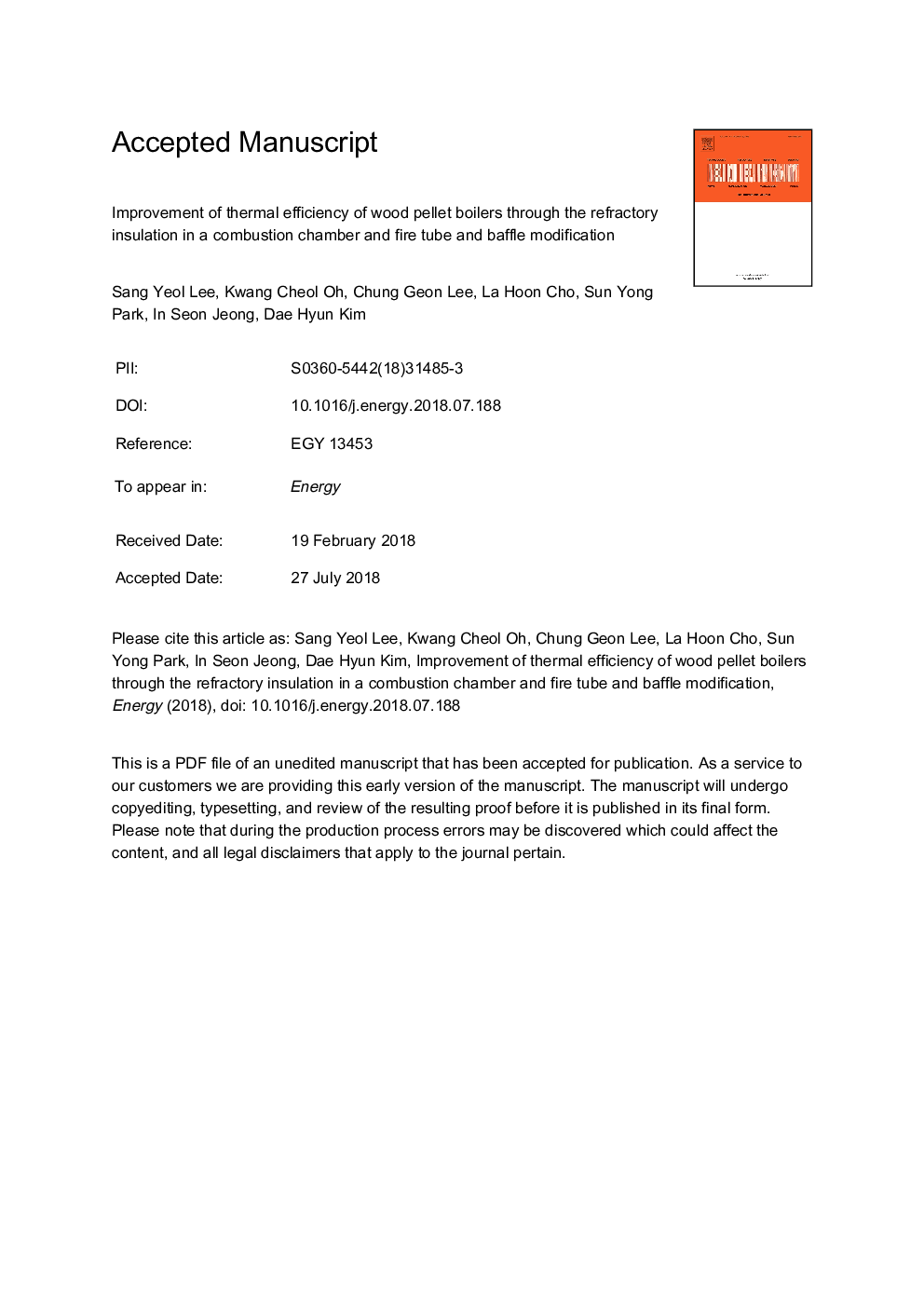| کد مقاله | کد نشریه | سال انتشار | مقاله انگلیسی | نسخه تمام متن |
|---|---|---|---|---|
| 8070907 | 1521389 | 2018 | 19 صفحه PDF | دانلود رایگان |
عنوان انگلیسی مقاله ISI
Improvement of thermal efficiency of wood pellet boilers through the refractory insulation in a combustion chamber and fire tube and baffle modification
ترجمه فارسی عنوان
بهبود راندمان حرارتی دیگهای گرانول چوب از طریق عایق نسوز در یک اتاق احتراق و اصلاح لوله آتش و بافر
دانلود مقاله + سفارش ترجمه
دانلود مقاله ISI انگلیسی
رایگان برای ایرانیان
کلمات کلیدی
دینامیک سیالات محاسباتی، گلوله چوبی، دیگ پلت، بازده حرارتی، تار،
ترجمه چکیده
هنگامی که گلوله های چوبی با رطوبت بالا به عنوان سوخت استفاده می شود، تولید تار در طول فرایند احتراق افزایش می یابد. در نتیجه، مشکلات مختلفی شامل کاهش راندمان حرارتی، افزایش انتشار گازهای آلاینده و نیاز به تمیز کردن اتاق احتراق می شود. برای مقابله با این مشکل، این تحقیق، عایق نسوزی را اجرا کرد که در آن یک شبیه سازی دینامیکی سیال نشان داد که تنش های حرارتی به شدت رخ می دهد و تمیز کردن اغلب مورد نیاز است. سپس لوله های آتش نشانی و بازپروری به منظور کاهش راندمان جبران شد. یک دیگ بخار اصلاح شده بر اساس شبیه سازی تولید شد و آزمایش انجام شد. در شرایط غیر خالص، بازده حرارتی بویلرهای کنترل و اصلاح شده به ترتیب 92.20٪ و 90.63٪ بود، اما هنگامی که قیر بر روی دیواره های اتاق احتراق افزوده شد، دیگ بخار اصلاح شده در مقایسه با 81.79٪ برای دیگ بخار کنترل تغییرات در بازده حرارتی به علت وجود تار، با استفاده از شبیه سازی دینامیکی سیالات محاسباتی شرایط بدون تار و تار مطابقت داده شده و به ترتیب 91.83٪ و 85.25٪ به ترتیب در کنترل و 05/92٪ و 87.18٪ دیگ بخار اصلاح شده، ارائه توافق خوب با نتایج تجربی.
موضوعات مرتبط
مهندسی و علوم پایه
مهندسی انرژی
انرژی (عمومی)
چکیده انگلیسی
When wood pellets with high moisture content are used as fuel, the generation of tar during the combustion process increases. As a result, various problems occur, including decrease in thermal efficiency, increase in emission of polluting gases, and the need to clean the combustion chamber. To address this problem, this research applied refractory insulation where a fluid dynamics simulation indicated that thermal stresses most severely occurred, and cleaning was most often required. The fire-tube and baffle were then modified to compensate for the decrease in efficiency. A modified boiler was manufactured based on the simulation, and the experiment was performed. Under the no-tar condition, the thermal efficiencies of the control and modified boilers were found to be 92.20% and 90.63%, but once tar had accreted onto the combustion chamber walls, the modified boiler is more efficient at 82.55% compared to 81.79% for the control boiler. The changes in thermal efficiency due to the presence of tar were predicted using computational fluid dynamics simulations of no-tar and tar-accreted conditions, showing 91.83% and 85.25%, respectively, in the control and 92.05% and 87.18%, respectively, in the modified boiler, providing good agreement with the experimental results.
ناشر
Database: Elsevier - ScienceDirect (ساینس دایرکت)
Journal: Energy - Volume 161, 15 October 2018, Pages 1115-1121
Journal: Energy - Volume 161, 15 October 2018, Pages 1115-1121
نویسندگان
Sang Yeol Lee, Kwang Cheol Oh, Chung Geon Lee, La Hoon Cho, Sun Yong Park, In Seon Jeong, Dae Hyun Kim,
